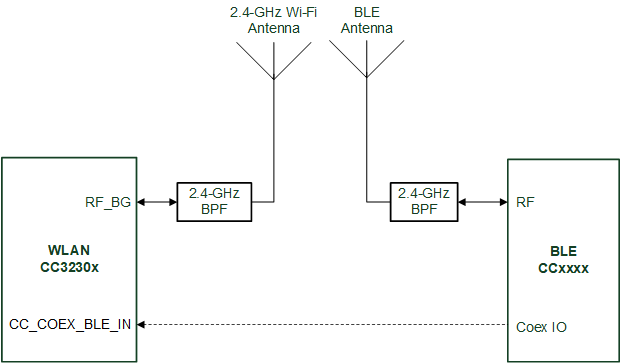SWRS226C February 2020 – December 2024 CC3230S , CC3230SF
PRODUCTION DATA
- 1
- 1 Features
- 2 Applications
- 3 Description
- 4 Functional Block Diagrams
- 5 Device Comparison
- 6 Terminal Configuration and Functions
-
7 Specifications
- 7.1 Absolute Maximum Ratings
- 7.2 ESD Ratings
- 7.3 Power-On Hours (POH)
- 7.4 Recommended Operating Conditions
- 7.5 Current Consumption Summary (CC3230S)
- 7.6 Current Consumption Summary (CC3230SF)
- 7.7 TX Power Control
- 7.8 Brownout and Blackout Conditions
- 7.9 Electrical Characteristics for GPIO Pins
- 7.10 Electrical Characteristics for Pin Internal Pullup and Pulldown
- 7.11 WLAN Receiver Characteristics
- 7.12 WLAN Transmitter Characteristics
- 7.13 WLAN Transmitter Out-of-Band Emissions
- 7.14 BLE/2.4 GHz Radio Coexistence and WLAN Coexistence Requirements
- 7.15 Thermal Resistance Characteristics for RGK Package
- 7.16
Timing and Switching Characteristics
- 7.16.1 Power Supply Sequencing
- 7.16.2 Device Reset
- 7.16.3 Reset Timing
- 7.16.4 Wakeup From HIBERNATE Mode
- 7.16.5 Clock Specifications
- 7.16.6 Peripherals Timing
- 8 Detailed Description
- 9 Applications, Implementation, and Layout
- 10Device and Documentation Support
- 11Revision History
- 12Mechanical, Packaging, and Orderable Information
Package Options
Mechanical Data (Package|Pins)
- RGK|64
Thermal pad, mechanical data (Package|Pins)
- RGK|64
Orderable Information
9.1.1 BLE/2.4 GHz Radio Coexistence
The CC3230x device is designed to support BLE/2.4GHz radio coexistence. Because WLAN is inherently more tolerant to time-domain disturbances, the coexistence mechanism gives priority to the Bluetooth® low energy entity over the WLAN.
The following coexistence modes can be configured by the user:
- Off mode or intrinsic mode
- No BLE/2.4 GHz radio coexistence, or no synchronization between WLAN and Bluetooth® low energy—in case Bluetooth® low energy exists in this mode, collisions can randomly occur.
- Time division multiplexing (TDM, single antenna)
- In this mode, (see Figure 9-1) the two entities share the antenna through an RF switch using two GPIOs (one input and one output from the WLAN perspective).
- Time division multiplexing (TDM, dual antenna)
- In this mode, (see Figure 9-2) the two entities have separate antennas, no RF switch is required, and only a single GPIO (on input from the WLAN perspective).
Figure 9-1 shows the single antenna implementation of a complete Bluetooth® low energy and WLAN coexistence network. The Coex switch is controlled by a GPIO signal from the BLE device and a GPIO signal from the CC3230x device.
 Figure 9-1 Single-Antenna Coexistence Mode Block Diagram
Figure 9-1 Single-Antenna Coexistence Mode Block Diagram
Figure 9-2 shows the dual antenna implementation of a complete Bluetooth low energy and WLAN coexistence network. Note in this implementation no Coex switch is required and only a single GPIO from the BLE device to the CC3230x device is required.
 Figure 9-2 Dual-Antenna Coexistence Mode Block Diagram
Figure 9-2 Dual-Antenna Coexistence Mode Block Diagram